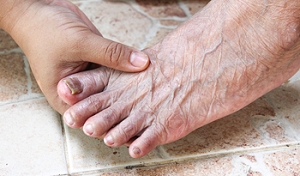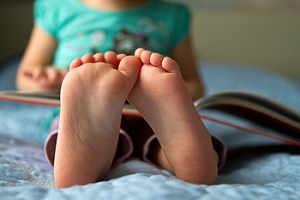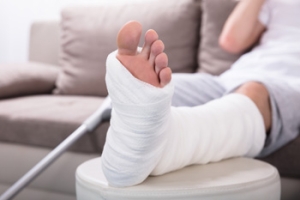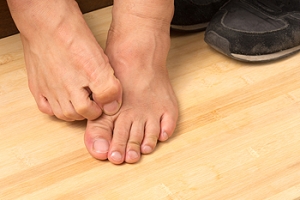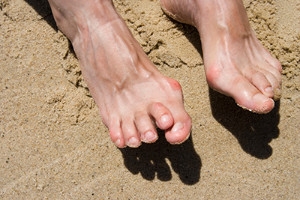
Things You Can Do to Care for Your Feet
If you are an older adult, you may have experienced foot problems. Unfortunately, foot problems are a common occurrence as we age. Fortunately, there are things that you can do to care for your feet and potentially prevent certain conditions from developing. One thing that you can do is perform a weekly foot check, in which you examine your feet for any problems, such as redness, swelling, cuts, sores, or punctures. Wearing comfortable, properly-fitted shoes is very important for maintaining good foot health. Improving your overall circulation, and thus improving circulation to your lower limbs, can help you stay on your feet. You can stretch, walk, or do other lower impact exercises. Regularly wash and dry your feet to maintain good hygiene, and moisturize your feet regularly to avoid dry skin. For more information about how to care for the feet as you age, please consult with a podiatrist.
Proper foot care is something many older adults forget to consider. If you have any concerns about your feet and ankles, contact Dr. Stephen Petrofsky from Florida. Our doctor can provide the care you need to keep you pain-free and on your feet.
The Elderly and Their Feet
As we age we start to notice many changes in our body, but the elder population may not notice them right away. Medical conditions may prevent the elderly to take notice of their foot health right away. Poor vision is a lead contributor to not taking action for the elderly.
Common Conditions
- Neuropathy – can reduce feeling in the feet and can hide many life-threatening medical conditions.
- Reduced flexibility – prevents the ability of proper toenail trimming, and foot cleaning. If left untreated, it may lead to further medical issues.
- Foot sores – amongst the older population can be serious before they are discovered. Some of the problematic conditions they may face are:
- Gouging toenails affecting nearby toe
- Shoes that don’t fit properly
- Pressure sores
- Loss of circulation in legs & feet
- Edema & swelling of feet and ankles
Susceptible Infections
Diabetes and poor circulation can cause general loss of sensitivity over the years, turning a simple cut into a serious issue.
If you have any questions please feel free to contact our office located in Port Charlotte, FL . We offer the newest diagnostic and treatment technologies for all your foot and ankle needs.
Elderly Foot Care
As you grow older, you will start to notice more problems with your feet due to wear and tear. This may also happen because the skin will start to become thin and lose elasticity. Some signs of aging feet are regular aches and pains, bunion development, and clawed toes.
Fortunately, there are ways you can improve comfort, relieve pain, and maintain mobility in your feet. One of the best ways to deal with aging feet is to exercise. If you keep active, your muscles will become toned which will then strengthen the arches in the foot and stimulate blood circulation.
It is important that you practice proper foot care to protect your aging feet. You should wash your feet in warm water on an everyday basis. Afterward, the feet need to be dried well and it is important to dry between the toes. Your toenails should be trimmed and kept under control; nails that are poorly cut may become ingrown. At the end of each day, performing an inspection of your feet will allow you to detect any ailments in their early stages.
As you grow older, it becomes more important that you wear comfortable shoes. Your shoes should be secure, and they should provide decent arch support. If you are looking to buy a new pair of shoes, it is best to look for a pair that are made from a breathable material. It is also helpful to have shoes that have a bit of extra room at the top of the shoe, especially if you suffer from swollen feet.
The most common foot problems that elderly people will encounter are bunions, calluses, corns, hammertoes, heel pain, and foot problems related to diabetes. Some other issues include arch pain, tarsal tunnel syndrome, Achilles tendonitis, and Morton’s neuroma
An annual foot examination is a great way for you to ensure that you do not have any serious health problems with your feet. You should talk to a podiatrist about the available treatment options for whichever foot issue you are dealing with.
Foot Conditions That May Occur in Children
 Pain in children's feet may be indicative of growing pains, or underlying medical conditions, and it is important to take notice if your child complains of general aches in their feet. Many young children are active and enjoy participating in running and jumping activities. This may cause sprains, fractures, or injuries to occur. Children who frequent public swimming pools and surrounding areas may get athlete’s foot, which is a fungal infection. Additionally, the medical condition that is known as Sever’s disease can affect the growth plate in the heel in young children, and may cause severe pain and discomfort. Occasionally, children may get bunions, and this can be caused by genetic factors or from wearing shoes that do not have adequate room for the toes to move freely in. It is suggested that your child is diagnosed by a podiatrist, who can properly manage existing foot pain.
Pain in children's feet may be indicative of growing pains, or underlying medical conditions, and it is important to take notice if your child complains of general aches in their feet. Many young children are active and enjoy participating in running and jumping activities. This may cause sprains, fractures, or injuries to occur. Children who frequent public swimming pools and surrounding areas may get athlete’s foot, which is a fungal infection. Additionally, the medical condition that is known as Sever’s disease can affect the growth plate in the heel in young children, and may cause severe pain and discomfort. Occasionally, children may get bunions, and this can be caused by genetic factors or from wearing shoes that do not have adequate room for the toes to move freely in. It is suggested that your child is diagnosed by a podiatrist, who can properly manage existing foot pain.
The health of a child’s feet is vital to their overall well-being. If you have any questions regarding foot health, contact Dr. Stephen Petrofsky of Florida. Our doctor can provide the care you need to keep you pain-free and on your feet.
Tips for Keeping Children's Feet Healthy
- Make sure their shoes fit properly
- Look for any signs of in-toeing or out-toeing
- Check to see if they have Clubfoot (condition that affects your child’s foot and ankle, twisting the heel and toes inward) which is one of the most common nonmajor birth defects.
- Lightly cover your baby’s feet (Tight covers may keep your baby from moving their feet freely, and could prevent normal development)
- Allow your toddler to go shoeless (Shoes can be restricting for a young child’s foot)
- Cut toenails straight across to avoid ingrown toenails
- Keep your child’s foot clean and dry
- Cover cuts and scrapes. Wash any scratches with soap and water and cover them with a bandage until they’ve healed.
If you have any questions, please feel free to contact our office located in Port Charlotte, FL . We offer the newest diagnostic and treatment technologies for all your foot care needs.
How to Care for Your Child's Feet
It is never normal for a child to experience pain in his or her feet. Foot pain that lasts more than a few days and limits a child’s ability to walk should be examined by a podiatrist. Many adult foot ailments originate in childhood and may be present at birth. Common foot issues that are experienced by children are pediatric flat foot, Sever’s disease, ingrown toenails, and plantar warts.
A child’s foot grows rapidly during the first year, allowing it to reach almost half of their adult foot size. Consequently, foot specialists consider the first year to be the most crucial point in the foot development process. There are ways you can help ensure that your child’s foot develops properly. One way is to carefully look at your baby’s feet. If you notice any deformities, you should immediately seek professional care. You should also loosely cover your child’s foot, since tight coverings may prevent movement and inhibit normal development. Another tip is to change the baby’s positioning throughout the day. If your baby lies down in one spot for too long, it may put an excess amount of strain on the feet and legs.
It is best that you try not to force a child to start walking. Children will begin to walk when they are both physically and emotionally capable to do so. You should also avoid comparing your child’s walking progress with other children because the age range for independent walking may range. When your child’s feet begin to develop, you may need to change both their shoe and sock size every few months to allow room for their feet to grow.
Kids are sometimes prone to splinters, cuts, and severe injuries because they tend to walk around barefoot. This also makes them more susceptible to developing plantar warts which is a condition caused by a virus that invades the sole of the foot through breaks in the skin. These ailments can be avoided by making sure your child wears shoes in unsanitary environments. You should also wash any minor cuts or scrapes on your child’s feet. It is a myth that exposure to fresh air will heal injuries; fresh air will only expose your child’s cuts to germs.
As a parent, you should ensure that your child’s feet are developing properly and are being properly maintained. Consequently, it is important that you perform routine inspections on his or her feet to detect any injuries or deformities in their early stages. Early detection and treatment will help to ensure that your child does not develop any serious foot conditions.
Is My Ankle Broken, or Sprained?
It can be difficult to tell the difference between an ankle that is broken and an ankle that is sprained. A break occurs when one or more of the three bones in the ankle joint, the tibia, fibula, or talus, is fractured. A sprain occurs when the ligaments that join the bones of the ankle are overstretched or torn. Both conditions may cause pain, swelling, bruising, and an inability to put weight on the affected ankle. If you have mild to moderate pain but can still put some weight on the ankle after an injury, then it is most likely a sprain. However, if you have pain that is severe or gets worse over time, can’t put weight on the injured ankle, have trouble moving the ankle, hear a popping noise at the time of injury, or notice that your ankle looks misaligned or deformed, then it is most likely a break. In any case, it is best to visit a podiatrist for a proper diagnosis and treatment plan.
Broken ankles need immediate treatment. If you are seeking treatment, contact Dr. Stephen Petrofsky from Florida. Our doctor can provide the care you need to keep you pain-free and on your feet.
Broken Ankles
A broken ankle is experienced when a person fractures their tibia or fibula in the lower leg and ankle area. Both of these bones are attached at the bottom of the leg and combine to form what we know to be our ankle.
When a physician is referring to a break of the ankle, he or she is usually referring to a break in the area where the tibia and fibula are joined to create our ankle joint. Ankles are more prone to fractures because the ankle is an area that suffers a lot of pressure and stress. There are some obvious signs when a person experiences a fractured ankle, and the following symptoms may be present.
Symptoms of a Fractured Ankle
- Excessive pain when the area is touched or when any pressure is placed on the ankle
- Swelling around the area
- Bruising of the area
- Area appears to be deformed
If you suspect an ankle fracture, it is recommended to seek treatment as soon as possible. The sooner you have your podiatrist diagnose the fracture, the quicker you’ll be on the way towards recovery.
If you have any questions, please feel free to contact our office located in Port Charlotte, FL . We offer the newest diagnostic and treatment technologies for all your foot care needs.
All About Broken Ankles
Broken ankles are a serious injury that can lead to an inability to walk, function, and also cause a significant amount of pain. A broken ankle is a break in one of the three bones in your body that connect at the ankle joint: the tibia, the fibula, and the talus. The tibia and fibula are your two primary leg bones that connect at the knee, which sit directly upon the talus bone. This is protected by a fibrous membrane that allows for movement in the ankle joint. A broken ankle is usually caused by the foot rolling under or twisting too far, causing one of these three bones to snap.
A broken ankle is different from an ankle sprain, which occurs when the ankle ligaments are ripped or torn but no bones have been broken. A sprain can still be very severe, causing bruising in the foot and an inability to hold your own weight, much like a broken ankle would. If you’re unable to stand, and suspect that you have a broken ankle, the first thing to do would be to get an immediate X-ray to determine the severity of the break.
A common cause of broken ankles is when the ankle is rolled over with enough pressure to break the bones. This usually happens during exercise, sports, or other physical activity. Another common cause is a fall or jump from a tall height.
One immediate treatment for pain relief is elevating the foot above your head to reduce blood flow to the injured area. You can also apply ice packs to your ankle to help reduce swelling, redness, inflammation, and pain. After these initial steps, getting a cast and staying off your feet as much as possible will aid in the recovery of the broken ankle. The less movement and stress the ankle has to endure, the more complete it will heal. A doctor can determine if surgery is needed in order to heal correctly. In these cases, an operation may be the only option to ensure the ability to walk properly again, followed by physical therapy and rehabilitation.
It is highly important to determine if surgery is needed early on, because a broken ankle can become much more severe than you realize. If not professionally treated, the broken ankle will inhibit your walking, daily functioning, and produce a large amount of pain. Treating your broken ankle early on will help prevent further damage to it.
What Should I Do if I Have Athlete's Foot?
 Tinea pedis, or Athlete’s foot as it is more commonly known, is a fungal infection of the skin and feet. It typically affects the spaces between the toes and is characterized by cracked, scaly skin. This infection is contagious and can be spread through contact with infected skin flakes or through contact with fungi in damp areas, such as public swimming pools. If you find yourself with athlete’s foot, it is important to keep the feet clean, dry, and cool, as the fungus thrives and multiplies in warm, moist environments. You should also avoid public swimming pools, public showers, and foot baths. Wear sandals if possible, or air out your shoes by alternating them every 2-3 days. Avoid wearing socks made from fabrics like nylon, which do not dry easily. Finally, follow your doctor’s prescribed treatments, which can include topical or oral antifungal medications. If you think that you may have athlete’s foot, it is suggested that you seek the care of a podiatrist.
Tinea pedis, or Athlete’s foot as it is more commonly known, is a fungal infection of the skin and feet. It typically affects the spaces between the toes and is characterized by cracked, scaly skin. This infection is contagious and can be spread through contact with infected skin flakes or through contact with fungi in damp areas, such as public swimming pools. If you find yourself with athlete’s foot, it is important to keep the feet clean, dry, and cool, as the fungus thrives and multiplies in warm, moist environments. You should also avoid public swimming pools, public showers, and foot baths. Wear sandals if possible, or air out your shoes by alternating them every 2-3 days. Avoid wearing socks made from fabrics like nylon, which do not dry easily. Finally, follow your doctor’s prescribed treatments, which can include topical or oral antifungal medications. If you think that you may have athlete’s foot, it is suggested that you seek the care of a podiatrist.
Athlete’s foot is an inconvenient condition that can be easily reduced with the proper treatment. If you have any concerns about your feet and ankles, contact Dr. Stephen Petrofsky from Florida. Our doctor will treat your foot and ankle needs.
Athlete’s Foot: The Sole Story
Athlete's foot, also known as tinea pedis, can be an extremely contagious foot infection. It is commonly contracted in public changing areas and bathrooms, dormitory style living quarters, around locker rooms and public swimming pools, or anywhere your feet often come into contact with other people.
Solutions to Combat Athlete’s Foot
- Hydrate your feet by using lotion
- Exfoliate
- Buff off nails
- Use of anti-fungal products
- Examine your feet and visit your doctor if any suspicious blisters or cuts develop
Athlete’s foot can cause many irritating symptoms such as dry and flaking skin, itching, and redness. Some more severe symptoms can include bleeding and cracked skin, intense itching and burning, and even pain when walking. In the worst cases, Athlete’s foot can cause blistering as well. Speak to your podiatrist for a better understanding of the different causes of Athlete’s foot, as well as help in determining which treatment options are best for you.
If you have any questions please feel free to contact our office located in Port Charlotte, FL . We offer the newest diagnostic and treatment technologies for all your foot and ankle needs.
How to Deal with Athlete's Foot
Athlete’s foot is a type of fungal infection that affects the skin on the feet. It is caused when the tinea fungus grows on the foot. It is possible to catch the fungus through direct contact with someone who has it or by touching a surface that is contaminated with it. This type of fungus thrives in warm, moist environments such as showers, locker room floors, and swimming pools. Your risk of getting it may also increase by wearing tight-fitting, closed-toe shoes, or by having sweaty feet.
Symptoms of athlete’s foot include itching, stinging or burning sensations between the toes. You may also experience toenails that are discolored, thick, crumbly, or toenails that pull away from the nail bed.
Your podiatrist may diagnose athlete’s foot by detecting these symptoms or by doing a skin test to see if there is a fungal infection present. The most common exam used to detect Athlete’s foot is a skin lesion potassium hydroxide exam. To use this method, your doctor will scrape off a small area of the infected skin and place it into potassium hydroxide. The potassium hydroxide will destroy the normal cells and leave the fungal cells untouched so that they are visible under a microscope.
There are a variety of treatment options for athlete’s foot. Some medications are miconazole (Desenex), terbinafine (Lamisil AT), clotrimazole (Lotrimin AF), butenafine (Lotrimin Ultra), and tolnaftate (Tinactin). While these options may be able to treat your fungus, it is best that you consult with a podiatrist in order to see which treatment option may work best for you.
In some cases, Athlete’s foot may lead to complications. A severe complication would be a secondary bacterial infection which may cause your foot to become swollen, painful, and hot.
There are ways that you can prevent athlete’s foot. Washing your feet with soap and water each day and drying them thoroughly is an effective way to prevent infections. You also shouldn’t share socks, shoes, or towels with other people. It is crucial that you wear shower sandals in public showers, around swimming pools, and in other public places. Additionally, you should make sure you wear shoes that can breathe and change your socks when your feet become sweaty. If you suspect that you have Athlete’s foot, you should seek help from a podiatrist as soon as possible.
Ways to Prevent Hammertoe
Hammerto e is a deformity of the toes that causes the small toes to bend at the joint. If left untreated, hammertoes can be permanent. Common signs of hammertoe include curling toes, thickening of the skin on the affected toe, trouble finding shoes that fit correctly, and pain. One of the leading causes of hammertoe is poor fitting shoes. Avoid shoes that have a narrow and pointed toe, that are too tight, or that have a high heel. Shoes that have wide toe boxes and are roughly a half inch longer than your longest toe are generally best to reduce the risk of hammertoe. A proper diagnosis and treatment plan for hammertoe will require visiting a podiatrist, so if you believe that you are suffering from hammertoe, consult with a podiatrist as soon as possible.
e is a deformity of the toes that causes the small toes to bend at the joint. If left untreated, hammertoes can be permanent. Common signs of hammertoe include curling toes, thickening of the skin on the affected toe, trouble finding shoes that fit correctly, and pain. One of the leading causes of hammertoe is poor fitting shoes. Avoid shoes that have a narrow and pointed toe, that are too tight, or that have a high heel. Shoes that have wide toe boxes and are roughly a half inch longer than your longest toe are generally best to reduce the risk of hammertoe. A proper diagnosis and treatment plan for hammertoe will require visiting a podiatrist, so if you believe that you are suffering from hammertoe, consult with a podiatrist as soon as possible.
Hammertoes can be a painful condition to live with. For more information, contact Dr. Stephen Petrofsky of Florida. Our doctor will answer any of your foot- and ankle-related questions.
Hammertoe
Hammertoe is a foot deformity that occurs due to an imbalance in the muscles, tendons, or ligaments that normally hold the toe straight. It can be caused by the type of shoes you wear, your foot structure, trauma, and certain disease processes.
Symptoms
- Painful and/or difficult toe movement
- Swelling
- Joint stiffness
- Calluses/Corns
- Physical deformity
Risk Factors
- Age – The risk of hammertoe increases with age
- Sex – Women are more likely to have hammertoe compared to men
- Toe Length – You are more likely to develop hammertoe if your second toe is longer than your big toe
- Certain Diseases – Arthritis and diabetes may make you more likely to develop hammertoe
Treatment
If you have hammertoe, you should change into a more comfortable shoe that provides enough room for your toes. Exercises such as picking up marbles may strengthen and stretch your toe muscles. Nevertheless, it is important to seek assistance from a podiatrist in order to determine the severity of your hammertoe and see which treatment option will work best for you.
If you have any questions, please feel free to contact our office located in Port Charlotte, FL . We offer the newest diagnostic and treatment technologies for all your foot care needs.





